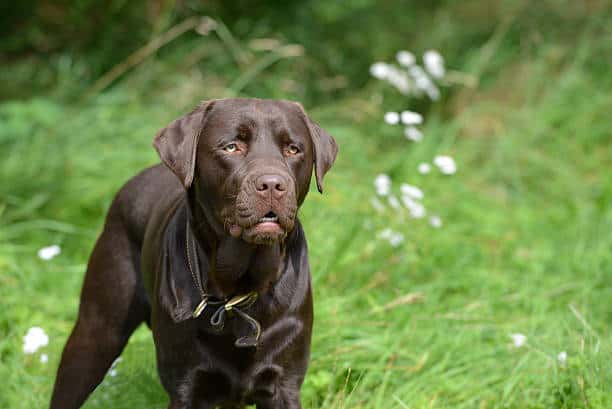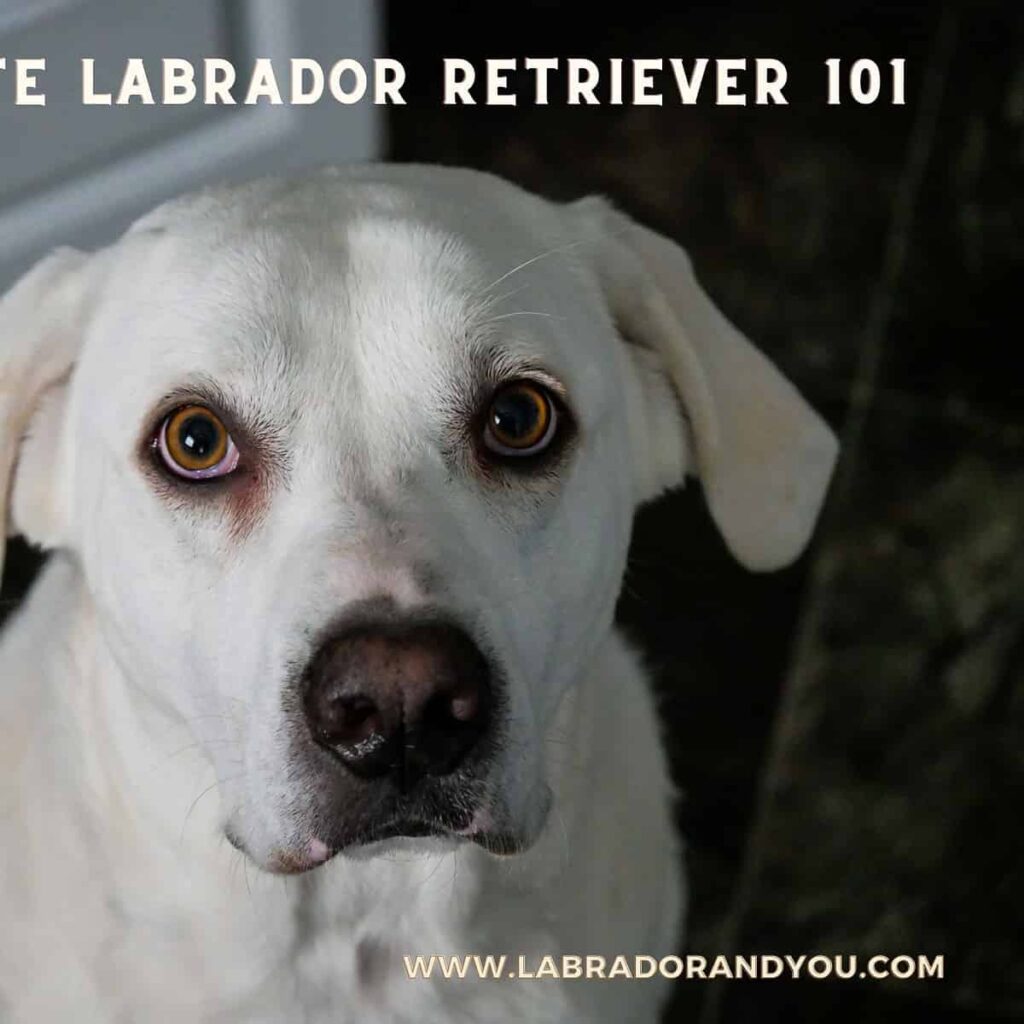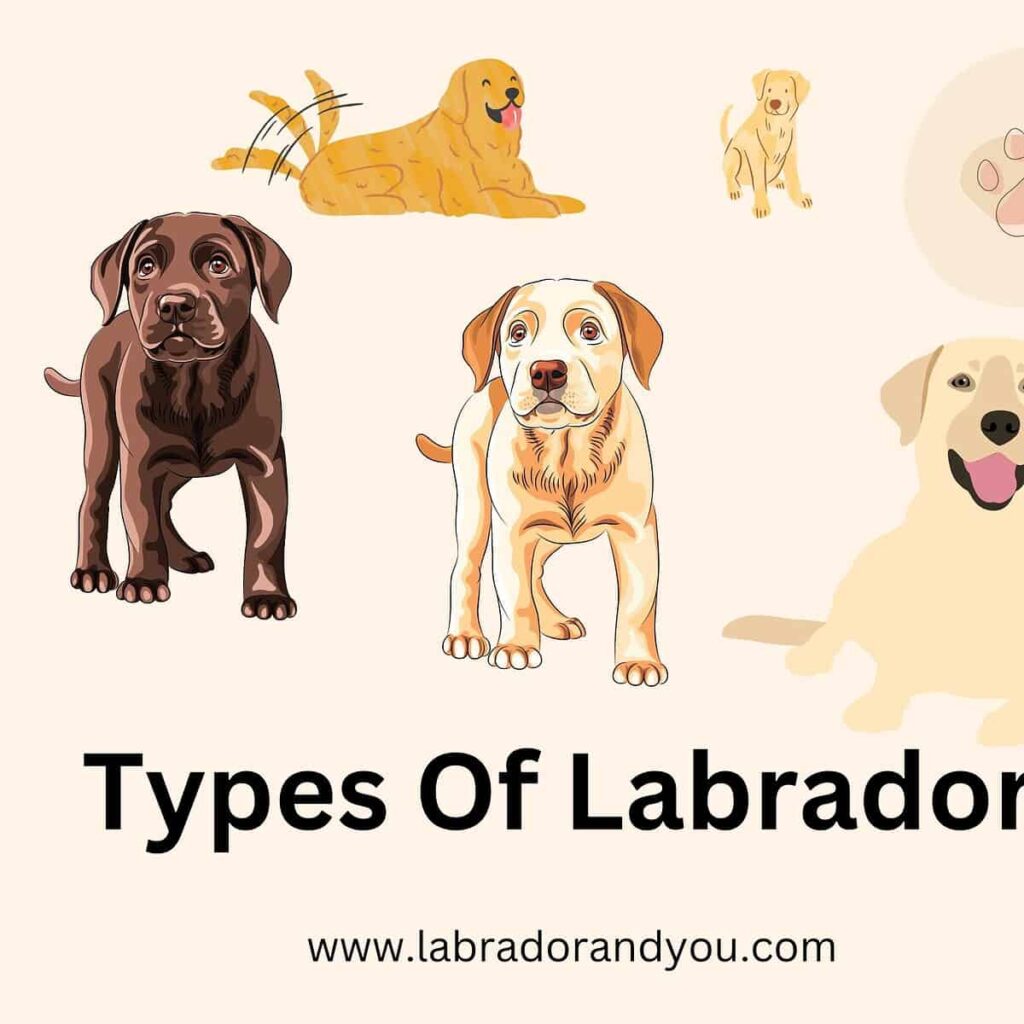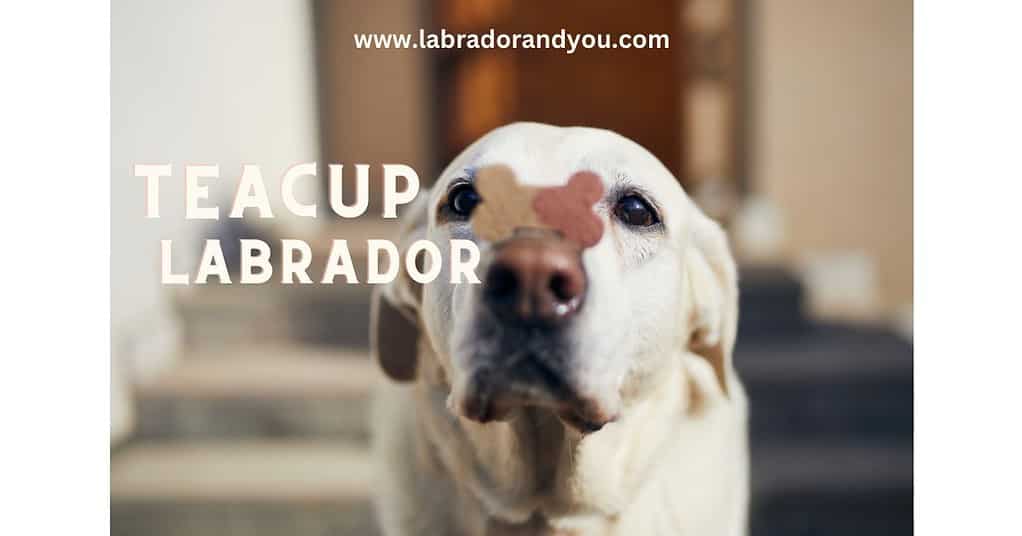If you’re considering adding a beloved English Lab to your family or simply curious, knowing what makes them unique can be truly important. Did you know the breed has some distinctive characteristics, like its iconic floppy ears and thick double coat? Stick around as we share valuable insights about these hardworking yet gentle companions.

Decoding the English Labrador Retriever
The English Labrador Retriever, a distinct member of the broader Lab family, possesses unique features and characteristics that make it stand out. Originating from Britain, this breed has etched its name as the “English Lab”, setting itself apart with its robust body shape and calm temperament.
From their broad heads to their iconic otter tails—working through their origins and history will give us a clearer understanding of what makes an English Lab wonderfully distinct.
Origin and History
Labradors started as field dogs in England. They helped hunters get birds from the water or bushes. Over time, people bred these Labs to have different traits. Some liked the features that made them good hunting dogs.
Others chose looks and calm ways of showing off at dog shows and living with families. In fifty years, two types of Labs were born: English Labs and American Labs.
English ones are also known as Show or Bench Labradors in England, while American ones are called working or field-bred Labradors.

The term “English Lab”
The name “English Lab” sets it apart from other types of Labrador Retrievers. It tells us about the dog’s roots in England. English Labs are also called Bench or Show Labradors. These dogs have been bread for shows instead of hunting at work like their American cousins, the Field-bred or Working Labs. Their split happened fast over a short span of fifty years but left a mark on their traits and roles in society.
Characteristics of the English Lab
The English Lab, known for its distinctive physical traits like the broad head and otter tail, boasts a sturdy body shape covered in a rich double coat.
Besides their charming looks, these Labs are highly regarded for their calm temperament and impressive variety of colors, including black, chocolate, and yellow. Their features make them visually striking and contribute to their versatility as popular family pets and diligent service dogs.

Physical Appearance
English Labs have a very unique look. Here are the ways you can tell them apart:
- English Labs have a long, wide face. This makes them look kind of serious!
- They have floppy ears that hang down. These make them look cute and friendly.
- Their chest is big and round, like a barrel.
- Their tail sticks straight out and is thick, similar to an otter’s tail.
- English Labs have three main colors: black, chocolate or yellow.
- There are some differences in their coat colors because of special kinds of genes.
- Most English Labs also have a double coat, which keeps them warm when it’s cold outside!
Broad Head
English Labs have a wide and strong head. This is one of their key features. Those that take part in shows often have bigger heads and heavy bodies. It helps to give them a full look.
The broad head also shows their joyful love for meeting people and other animals. This makes the English Lab really just right as family pets or show dogs.
Body Shape
English Labs have a sturdy look. They have short legs and wide chests. Their body is not long like American Labs. A big head sits on top of their strong body, making them stand out.
This lab breed has more weight than its peers due to its shape. Some may say they look bulky or heavy but this is how an English Lab should be! It’s all part of their charm and what makes them special among Lab breeds.

The Otter Tail
The otter tail of an English Lab is a big trait. It helps them swim when they fetch in the water. They use it like other animals would use a paddle. Most times, their tails are thick and straight too. This makes them different from American Labs that have slimmer tails.
Coat Type
English Labs have a double coat. This type of fur keeps them warm in cold weather and cool in hot weather. Their coat is also very thick, making it great for swimming and playing in water.
The colors of the English Lab’s coat can vary. They can be silver, charcoal, champagne, black, chocolate or yellow. You will need to brush their hair often so it looks clean and shiny.
English Lab Temperament
English Labs are friendly and gentle dogs. They love to be around people and other pets. These Labs can make friends with almost anyone! They also have a calm nature that many people like.
Training them is not hard because they learn quickly. This smartness makes English Labs great for those who never had a dog before. But, these dogs do like to play too! Even though they may seem less active outside, their playful streak comes out when playing games or running in the yard.

English Lab Colors
These English Labs have three main coat colors. These are black, chocolate, and yellow. The black Lab has a strong coal-black shade all over its body. A chocolate Lab comes in deep brown color. The yellow Lab can range from light cream to a rich golden hue.
Some English Labs show different colors because of diluted genes and selective breeding. This is why you might also see silver or “fox red” labs! It’s fascinating how a breed can hold such diverse shades within it!
Comparing English Lab with American Lab
Dig into an in-depth comparison between English Labs and their American counterparts, understanding crucial differences from physical features to temperament.
Physical Differences
The physical differences between English and American labs are quite distinct. These differences primarily revolve around their overall body structure, size, head shape, and tail type.
| Attributes | English Lab | American Lab |
|---|---|---|
| Body Structure | English Labs have a long, broad muzzle and a wide head. | American Labs have a more athletic appearance with a slimmer body and longer legs. |
| Size | Male English Labs stand 22.5-24.5 inches tall and weigh 70-80 lbs, while females are 21.5-23.5 inches tall and weigh 60-70 lbs. | American Labs are slightly leaner and taller than English Labs. |
| Head Shape | English Labs have a long broad muzzle and a wide head. | American Labs have a thinner and longer muzzle. |
| Tail Type | English Labs have a thick otter-like tail. | American Labs have a thinner tail compared to English Labs. |
These physical differences contribute to each type of Lab’s unique charm and personality. The English Lab’s sturdy build and calm demeanor make it a great companion dog, while the agile American Lab excels in field and hunting activities.

Temperament and Energy Levels
English Labs are known for their sweet, relaxed temperament making them excellent family pets. Yet, they still require much exercise to keep them healthy and fit. On the other hand, American Labs are more athletic and energetic, needing lots of physical activity and mental stimulation.
| English Lab | American Lab |
|---|---|
| English Labs have a more relaxed, easy-going temperament. | American Labs are known for their high energy levels and need for physical activity. |
| Although they need exercise, English Labs may be less energetic and driven outdoors than their American counterparts. | They are sporty and love to play and participate in outdoor activities. |
| English Labs can also be more playful and distractible, sometimes making training a bit more challenging. | American Labs require regular physical and mental stimulation due to their high energy levels. |
| English Labs can also be more playful and distractible, which can sometimes make training a bit more challenging. | American Labs are highly trainable due to their affinity for physical activities and mental stimulation. |
Training Differences
English Labs and American Labs have different training needs due to their diverse physical characteristics and energy levels. Training an English Lab revolves around fun and engaging activities, while an American Lab needs a structured and disciplined approach. The table below highlights these differences.
| Features | English Lab | American Lab |
|---|---|---|
| Training Approach | Fun-Based | Structured and Disciplined |
| Energy Levels | Lower | Higher |
| Training Needs | Interactive Games and Puzzles | Intensive Training and Exercise |
This information is essential in understanding the training differences between the two, ensuring a successful and beneficial training experience for both the dog and owner. Choosing a training method that suits the breed’s needs is key to promoting positive behavior and a balanced temperament.

Health Concerns in English Labs
While notably robust, English Labs are predisposed to certain health issues including obesity, genetic disorders like hip dysplasia and retinal atrophy, along with common diseases such as diabetes.
Careful weight monitoring and regular veterinary checkups are imperative in maintaining their overall health. Genetic testing can also be beneficial in identifying potential risks for hereditary conditions earlier on.
Obesity
Obesity is a problem for English Labs. They can get fat quickly. Too much food and little exercise can cause this. Their genes also make them prone to obesity. When they weigh too much, it can bring health troubles like joint issues and heart diseases. So, it is key to keep an English Lab’s weight in check for good health.
Genetic Disorders
English Labs can have health issues in their genes. Some may grow extra hairs on the eyelid that hurt the eye. This is known as distichiasis. Others might have a problem with a heart valve called tricuspid valve dysplasia which leads to fast heartbeat and hard time exercising.
Also, some English Labs can develop muscular dystrophy, stiff muscles cause this issue and it also affects swallowing. Lastly, cataracts are common too. Cataracts blur the dog’s vision making day-to-day tasks challenging.
Common Diseases
English Labs can get sick often. Joint issues like hip dysplasia and elbow problems are common in these dogs. They might also have eye troubles such as cataracts and retinal problems. Some might have diabetes or cancer. These diseases can make a Lab’s life hard.
Another problem is obesity, which some Labradors are more prone to than others. Obesity can lead to major health issues without diet and exercise. Distichiasis is a strange condition in English Labs, where extra hairs grow on the eyelid. This causes constant blinking squinting, and may irritate the eyes.

Grooming Needs of an English Lab
You must handle its grooming needs to keep an English Lab clean, bright, and healthy. Here is what you should do:
- Brush your English Lab’s coat often to stop shedding.
- Bathe your dog only when needed so as not to dry out their skin.
- Clean your Lab’s ears once a week or when they seem dirty.
- Cut their nails every two weeks, or if you hear them clicking on the floor.
- Brush their teeth daily with dog-safe toothpaste to stop gum disease.
- Look for eye troubles during grooming times as Labs can have eye issues.
- Keep an eye out for lumps or bumps on your pet’s body when brushing; these might sign health problems.
Choosing Your English Lab
Choosing your English Lab involves careful consideration of lifestyle, breeder reputation, and potential health issues. We’ll guide you through what to look for in an excellent match.
Considerations for Potential Owners
If you want to get an English Lab, think about the facts below:
- English Labs are kind. They love people and other animals.
- These dogs need daily play or walks. They enjoy swimming also.
- It’s key to feed them right. This keeps them from getting too fat and sick.
- Be ready for the joy these dogs bring to a home.
- These dogs can live up to 12 years if well taken care of.
- Due to their double coat, English Labs shed quite a bit, requiring regular grooming.
- Make sure you have enough space at home as English Labs grow into large size dogs with a barrel chest, but are friendly and calm in nature.
- Training should start when they are puppies. Early social skills make them better pets later on in life.
English Lab Breeders
Picking the right English Lab isn’t only about their looks. The breeder you choose plays a big part too. Good breeders care for the health and well-being of their dogs. They make sure that each puppy is strong and happy.
Many good English Lab breeders are out there, but take your time to find them. Don’t rush into buying a pup from the first one you meet! Ask questions, visit their place if you can, look at how they treat all of their dogs. This way you’ll be sure your new furry friend comes from a loving home!
Training Your English Lab
Dive into the world of training English Labs, exploring effective techniques tailored to their unique temperament and ways to address common behavioral issues.
Effective Techniques for English Labs
Training your English Lab is not hard. They are smart dogs. But you must know the best ways to train them. Use these tips for good results:
- Make training fun: English Labs have a lot of energy. They love the play! Use games and toys in training.
- Give rewards: When your dog does what you ask, give a reward right away. This can be a treat or just a pat on the head.
- Be kind and calm: Never shout at or hit your dog. Stay calm, even if they make mistakes.
- Keep lessons short and simple: Long classes might bore your dog or tire them out.
- Train every day: Short lessons each day build habit better than long, less frequent ones.
- Use body language: Dogs understand gestures well. For example, show them how to sit by pushing gently on their back end.
- Class time should happen after exercise: A tired lab is much more eager to learn than an energetic one!
- Do all actions repeatedly, with order: Labs learn fastest with routine steps.
- Teach “no” command from young age: This can keep them from picking up bad behavior later on.
Addressing Common Behavioral Issues
Training your English Lab is important to avoid bad habits. Here are some common issues and ways to fix them:
- Chewing: Give them toys or treats they can chew on.
- Jumping on people: Show them how to sit when they meet new people.
- Barking too much: Let them know when it’s alright to bark and when it’s not.
- Pulling on the leash: Teach them to walk by your side, not in front of you.
- Not coming when called: Practice calling their name and rewarding them when they come.
Feeding Your English Lab
Implementing a healthy diet for an English Lab is vital as they are prone to obesity. Now we will talk more about the recommended food types, quantity, and meal frequency needed for your furry friend’s health.
Recommended Diet
English Labs need a certain kind of food. It helps keep their energy up and stops them from getting fat. So, it is good to pick high-grade food just for Labs. Here’s the diet you should follow:
- Give them food rich in protein.
- Make sure they get carbohydrates too.
- Add some fats to their diet but not too much.
- Keep an eye on how much they eat so they don’t get fat.
- Divide their food into small meals throughout the day.
Foods to Avoid
Feeding your English Lab the right food is very important. There are, however, some foods that you must not give to your English Lab. Here is a list:
- Chocolate: it has theobromine which is toxic to your Lab.
- Onions and garlic: these can cause anemia in dogs.
- Grapes and raisins: these can hurt your Lab’s kidneys.
- Avocado: it has persin, a harmful substance for dogs.
- Alcohol: it can poison your dog and even kill them.
- Coffee and other foods with caffeine should also be off-limits as they harm Labs.
- Macadamia nuts and xylitol are bad for Labs, too.
English Lab in Different Colors
Curious about their color variations and what influences them? Stay tuned to learn more!
Yellow Lab
Yellow Labs are a sight to see! Their coat shines like the sun. English labs can be yellow too. These lovely dogs have some black parts, even though they look all yellow.
The main areas with black pigment are around their eyes and on their noses. They should not appear to be white or golden but true yellow.
Some Yellow English Labs also have black noses giving them a unique look. You will never mistake an English Yellow Lab for another breed when seeing one in person because of its eye-catching color and shape!
Chocolate Lab
Chocolate Labs are a kind of English Lab. They look the same as other English Labs. They have a coat that they lose two times in a year. This means you will have to brush them often.
Chocolate labs are smart and learn fast, so many become service dogs. You can buy a Chocolate Lab puppy for $800 to $1200.

Black Labs
Black Labs are one of the most popular dog breeds in the world, and for good reason. They are known for their friendly and gentle temperament, intelligence, and trainability. Black Labs are also very active dogs, and require a lot of exercise.
FAQs
Which Lab is smarter: English or American?
Both English and American Labs are smart. But they show it in different ways. English Labs love to make friends. They get joy from making people happy. On the other hand, American Labs show their smarts in work tasks.
They have a high drive to go for games or hunts outdoors. Yet, both types learn quickly during training. So, neither one is really smarter than the other!
Are English Labs easier to train?
English Labs are often viewed as easier to train than other dog breeds. They have a love for learning and enjoy pleasing their owners. This makes them great for first-time dog owners.
The English Lab’s smart mind picks up new skills fast. Use of fun games can make training easy and enjoyable. Praise, toys, or treats also help reward good behavior in English Labs. But even though they learn quickly, it’s crucial to keep patience while training any dog breed including the English Lab.
Is an English Lab a good family dog?
Yes, an English Lab makes a great family dog. They love to be around people. They get along well with kids and other pets too. With the right training, they behave very well at home.
Their kind nature tends to shine in a family setting. These dogs are playful but also chill out when needed. You can trust them not to hurt small children during play times.
Why Did Labradors Split into English and American Labs?
Labradors split into English and American lines for many reasons. The main reason was the need for different job duties in the field and show ring. Labs first came as one kind, used to get game from fields.
In less than fifty years, this breed changed quickly. Some dogs were raised to be shown off in shows. Over time, these dogs got bigger bodies, shorter legs, and larger heads. Others kept working in fields where they needed speed and skill.
This made them quite fit! Today’s English Labs like meeting new people more than catching prey now.
Are English Labs Shorter?
Yes, English Labs are slightly shorter than American Labs. The breed standard for English Labs allows for a height of 21.5 to 22.5 inches, while the standard for American Labs allows for a height of 21.5 to 24.5 inches. English Labs are 1 to 3 inches shorter than American Labs.
Where Did English Labs Come From?
English Labs have roots in England. They came from a breed known as the St. John’s water dog, which lived in Newfoundland in Canada. In the 1800s, British nobles saw these dogs at work and brought some back to England.
There, they bred them to create Labradors. The split into English Labs and American Labs happened later due to breeding for different roles: show dogs and working or hunting dogs.
Which Lab Is a Better Hunting Dog?
English Labs and American Labs both make great hunting dogs. But, they are different in some ways. English Labs are more laid-back. They have a chunky shape that helps them in the field.
They can handle cold weather better because of their thick coat. On the other hand, American Labs like to move a lot more, which is good when there’s much ground to cover for hunting. The best Lab for you depends on what kind of hunting you do and your own likes.
How much does an English Lab cost?
To buy an English Lab, you need to spend from $800 to $1200. The cost can change based on the breeder’s rate, location, and the puppy’s parents. Also, rare coat colors like silver may cost more.
Are English Labs calmer?
Yes, English Labs are often calmer than their American cousins. They have less energy and a cooled down prey drive. This makes them good pets for families with kids or other animals.
What are English labs known for?
English labs are loved for their big heads and wide bodies. These dogs have a strong, out-and-out tail resembling an otter’s. They wear shiny coats in black, chocolate or yellow colors.
Their warm faces show how happy and calm they are. These labs love being around people and other animals. English Labs always want to say hi and wag their tails at everyone they meet.
But these dogs aren’t just friendly faces but also good workers! From helping blind owners walk safely to finding keys hidden under the couch, English Labs stand up tall as one of the best dog breeds in the world!
Conclusion
English Labs are unique, friendly dogs. They look different and act different than other Labs. People love them as pets and service dogs because of their calm nature and big hearts. Get to know an English Lab – you will fall in love!
Author Profile
- Site Owner And Planning Specialist
-
Aritra, the founder of Labradorandyou.com, is a lifelong dog lover whose passion ignited for Labradors for their loyalty and intelligence. With extensive research and personal experiences, Aritra has become a Labrador expert, offering a rich resource on the breed. Labradorandyou.com provides reliable, timely, and evidence-based information, including Labrador-specific product reviews, training techniques, and care tips.
Labradorandyou.com was born out of Aritra's passion and his desire to share his profound knowledge about the breed. The site serves as a comprehensive resource, offering a wealth of up-to-date information for Labrador owners and enthusiasts alike
Also by the author
-
 FAQNovember 17, 2023How To Adopt An Emotional Support Dog?
FAQNovember 17, 2023How To Adopt An Emotional Support Dog?
-
 Mix-BreedsNovember 16, 2023Red Labradoodle Ultimate Guide: Breed Facts, Care Tips
Mix-BreedsNovember 16, 2023Red Labradoodle Ultimate Guide: Breed Facts, Care Tips
-
 Top BreedersNovember 8, 2023Breeding Labradors: Everything You Need to Know
Top BreedersNovember 8, 2023Breeding Labradors: Everything You Need to Know
-
 FAQOctober 17, 2023Do Dogs Like Music? Researchers Say Yes! Find Out
FAQOctober 17, 2023Do Dogs Like Music? Researchers Say Yes! Find Out





